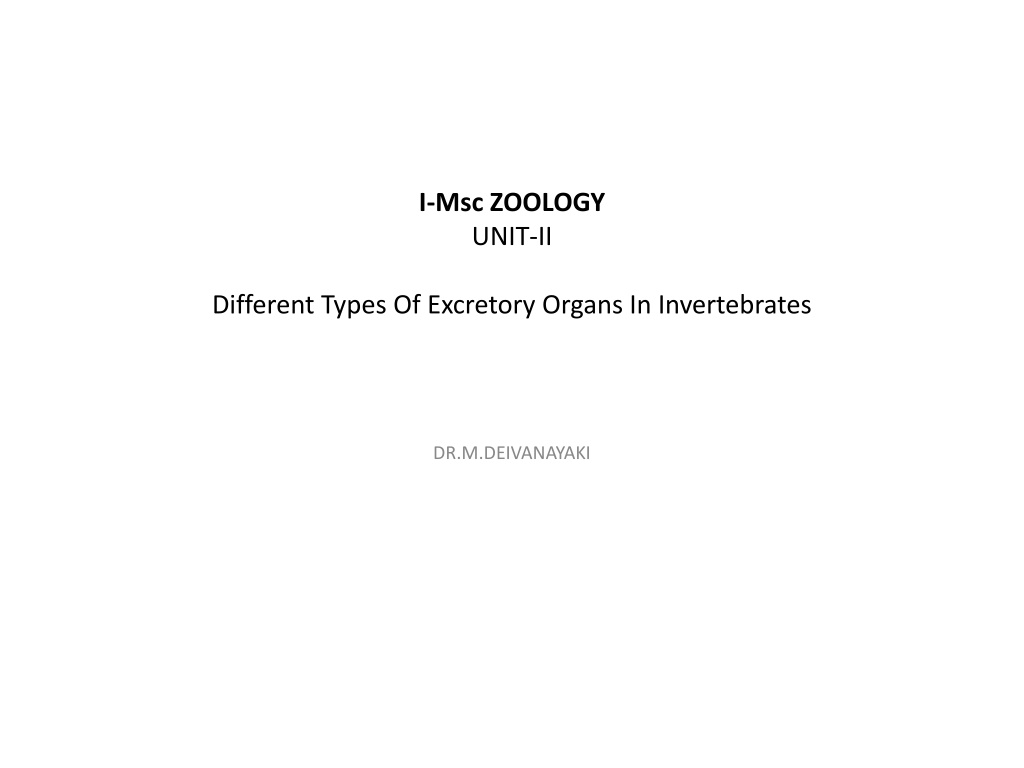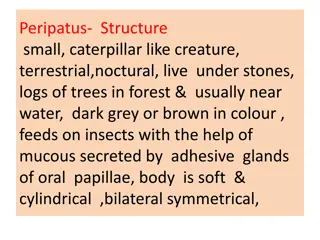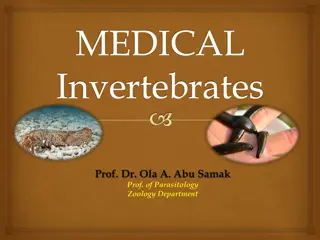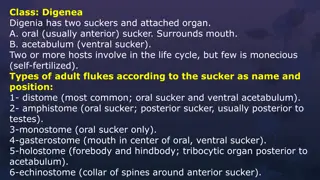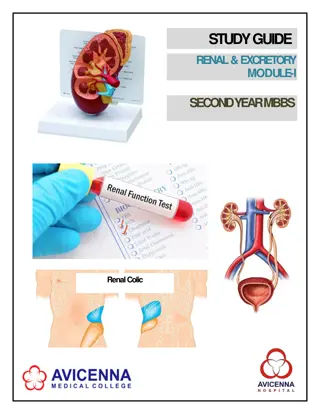Overview of Different Excretory Organs in Invertebrates
In invertebrates, there are various types of excretory organs such as the contractile vacuole, nephridium, renal gland, coxal gland, and Malpighian tubule. These organs play crucial roles in osmotic regulation and nitrogen excretion. Different phyla exhibit diverse excretory structures like nephridia in annelids, mollusks' renal glands, and coxal glands in aquatic arthropods. Understanding the diversity of excretory organs in invertebrates provides insights into their physiological adaptations.
Download Presentation

Please find below an Image/Link to download the presentation.
The content on the website is provided AS IS for your information and personal use only. It may not be sold, licensed, or shared on other websites without obtaining consent from the author. Download presentation by click this link. If you encounter any issues during the download, it is possible that the publisher has removed the file from their server.
E N D
Presentation Transcript
I-Msc ZOOLOGY UNIT-II Different Types Of Excretory Organs In Invertebrates DR.M.DEIVANAYAKI
This is not to say, however, that each invertebrate phylum has evolved its own particular type of excretory organ; rather, there appear to be five main types of invertebrate excretory organ: contractile vacuole, nephridium, renal gland, coxal gland, and malpighian tubule. Some protozoan animals possess an organelle having the form of an internal sac, or vacuole, which enlarges by the accumulation of a clear fluid and then discharges its contents to the exterior. The cycle of filling and emptying may be repeated as frequently as every half minute. The chief role of the contractile vacuole appears to be in osmotic regulation, not in nitrogen excretion.
The nephridia of annelids, nemertines, flatworms, and rotifers The word nephridium applies in its strict sense only to the excretory organs of annelids, but it may usefully be extended to include the excretory organs of other phyla having similar characteristics. Annelids are segmented animals that typically contain a pair of nephridia on each segment. Each nephridium has the form of a very fine tubule, often of considerable length; one end usually opens into the body cavity and the other to the exterior. In some annelids, however, the tubule does not open into the body cavity but ends internally in a cluster of cells of a special type known as solenocytes, or flame cells. The The renal glands of mollusks The anatomical form of the renal gland varies from one class of mollusks to another, but a common plan is clearly evident. The renal gland is a relatively wide tube opening from a sac (the pericardium) surrounding the heart, at one end, and to the mantle cavity (effectively to the exterior) at the other. There is a single pair of renal glands; in some forms one member of the pair may be reduced or absent. Clams have the simplest arrangement; the region nearest to the pericardium has glandular walls and gives way to a nonglandular, wider tube that extends to the urinary opening.
The vast majority of mollusks are aquatic and excrete nitrogen in the form of ammonia. In octopuses, however, nitrogen is excreted as ammonium chloride, which is quite strongly concentrated in the urine. Terrestrial snails and slugs excrete uric acid but may also excrete ammonia when living in moist surroundings. The coxal glands of aquatic arthropods Coxal glands are tubular organs, each opening on the basal region (coxa) of a limb. Since arthropods are segmented animals, it is reasonable to suppose that the ancestral arthropod had a pair of such glands in every segment of the body. In modern crustaceans there is, as a rule, only a single pair of glands, and in higher crustaceans these open at the bases of the antennae. Each antennal gland is a compact organ formed of a single tubule folded upon itself. When unraveled the tubule is seen to comprise three or four easily recognizable regions. The tubule arises internally as a small sac, the coelomic sac, which opens into a wider region, the labyrinth, having complex infoldings of its walls. The labyrinth opens either directly into the bladder, as in marine lobsters and crabs, or into a narrow part of the tubule, the canal, which in turn opens into the bladder, as in freshwater crayfishes.
The malpighian tubulesof insects Although some terrestrial arthropods (e.g., land crabs, ticks) retain the coxal glands of their aquatic ancestors, others, the insects, have evolved an entirely different type of excretory system. The malpighian tubules, which vary in number from two in some species to more than 100 in others, end blindly in the body cavity (which is a blood space) and open not directly to the exterior but to the alimentary canal at the junction between midgut and hindgut. The primary urine issuing from the malpighian tubules has to pass through the rectum before it leaves the insect s body, and in the rectum its composition is markedly changed. The insect excretory system therefore comprises the malpighian tubules and the rectum acting together.
